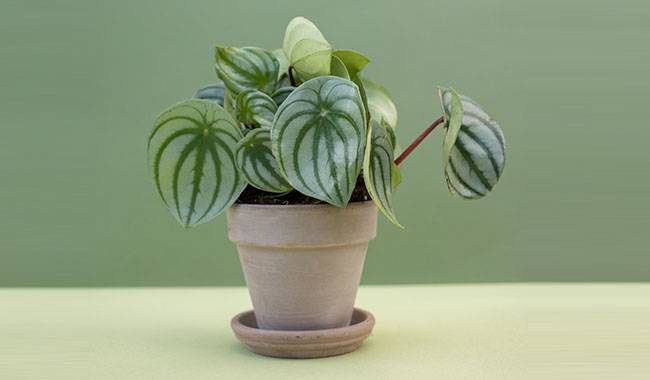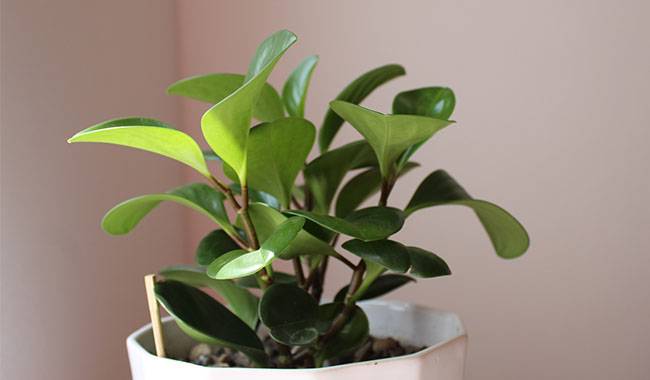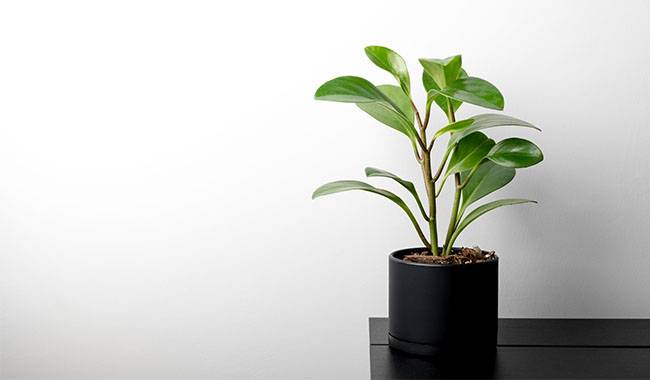
Peperomia (Radiator Plants) look lovely, but their beauty, texture, and the distinctive color of their small wrinkled leaves come at a price. This plant is not as demanding in terms of conditions as it is sensitive to negligent care. Careful care and constant attention will not only keep Peperomia shrubs alive for months after purchase but will also allow for good growth and lushness. However, watering is not the only thing to remember. There are quite a few rules for cultivating Peperomia, and breaking them will result in the loss of decorative qualities of a beloved houseplant. You will learn how to grow Peperomia plants in ThumbGarden’s article.
Peperomia is known for the patterns and textures of its foliage. Evergreen and always compact fashionistas offer hundreds of variations of greenery to choose from. Lanceolate, round, oval, and heart-shaped Peperomia leaves are surprising with their fleshy texture, pubescence or sheen, and unusual hues.
Wrinkled or smooth, rough or velvety, Peperomias offer every possible metallic effect – gold, silver, copper, emerald, blue, pink, red, purple, magenta, brown, olive, and gray in bizarre shades.
The originally asymmetrical inflorescences, reaching out in all directions, make the plant even more unusual. Peperomia can complement interior textiles, accentuate the play of textures in room decor, or serve as a gorgeous accent.
Finding the right conditions for the plant is easy: a universal loose substrate, good drainage, a place with light, protection from direct sunlight for unusual cultivars, and a room that is not very hot but warm for green cultivars – the minimum temperature allowed is 60 °F (16°C) – that’s all pereromyas need.
On the other hand, care is always considered to be the most difficult part of growing Peperomia. The maintenance of the shrub depends directly on the owner’s responsibility, and this plant is not for everyone. If there is no possibility to provide regular care, it is better to enjoy Peperomia as a guest.
Let’s understand the simple but very important rules of care to ensure the plant’s health.
No need to increase air humidity
Peperomia is often considered a plant that cannot grow in normal office and living room environments, forgetting its fleshy leaves and dislike of humidity. Not only is this plant unnecessary, but it is also dangerous in tropical “greenhouse” conditions. Ideally, 55-60% humidity is sufficient, and most varieties will surprise you with their ability to adapt to normal conditions.
For varieties with smooth leaves, spray in summer if needed (at least twice a week); adolescent types should certainly not be wet, but there is no need to install a humidifier for them either.
Do not over-water
Watering Peperomia can be a tricky task. A balance must be struck between preventing the soil from drying out entirely and risking the slightest over-watering. Usually, the soil dry out to about half of the pot, at the top and part of the middle layer. Watering the plants frequently but moderately is best, maintaining a light but steady moisture level and watering immediately. In winter, this is much easier: you only need to water Peperomia after the soil has dried out.
Bubbles usually mark overwatering and waterlogging on the leaves. If you notice this strange change, you should correct the watering immediately. However, it is best not to signal Peperomia itself and regularly check the substrate.

Do not over-fertilize
Only fertilizers for ornamental foliage plants with a high nitrogen content are suitable for Peperomia. When choosing a fertilizer, make sure that it includes macro-nutrients and micro-nutrients. Otherwise, the pattern will not be complete.
Peperomia does not like excessive fertilization. Its roots are fragile and can be burned if too much fertilizer is applied or long-lasting fertilizer sticks and granules are used. Therefore, standard doses of fertilizer should be prioritized in reduced quantities. The safest way is to divide the manufacturer’s quantity into several smaller doses and apply them more frequently than once every two weeks. For example, you can add fertilizer in microdoses at each watering.
Use only warm water
Peperomia is very sensitive to salinity. Even normal standing water may not be to their liking. Rainwater, melted, filtered, or – in extreme cases – boiled water is best for this plant.
This plant should not be watered even at room temperature. Peperomia is very afraid of excessive cold, so the water temperature should always be 35-39 °F (2-4°C) higher to minimize the risk.
For winter, the brightest place
The surroundings need to be maintained with the same regime throughout the year. And whether it will wilt, shrivel and elongate in the fall instead of being lush as usual depends on the owner. Once daylight hours arrive, even plants accustomed to soft light and penumbra need to be gradually brought closer to the windows. Make sure they are placed in the brightest part of the house during the winter.
If possible, you can compensate for the lack of light by increasing the amount of light from October to winter so that you can achieve the usual 12 hours of daylight.
Cleanliness – above all
Dirt on Peperomia leaves hard to see, but that doesn’t mean it’s acceptable. Dust is a perfect helper for pests. If not kept clean, the plant will soon lose its fresh appearance and dry out for no particular reason. Smooth leaves are easy to wipe off, and wrinkled varieties must be brushed off or gently blown off.
The top layer of the substrate should also be kept clean. The natural accumulation of plant “debris” is inevitable over time, and traces of salt deposits, mold, and moss can be seen on the soil’s surface if it is not watered properly. Contamination of topsoil interferes with air exchange and increases the risk of leaf infestation and decay. Topsoil should be replaced with fresh soil every six months. If decorative mulch is used, it should be renewed as deposits appear.
The hygiene of the container is also important for Peperomia bacteria. Pots should always be clean and free of any traces of scale or soil. This microscopic contamination can be a source of the infestation.
Time your transplants well
Peperomia does not like to be disturbed, so it is best to change containers only when the shrub is very large, and the root system takes up all the space of the previous container. Peperomia is usually replanted every 2 years. Transplanting should not be done in a hurry only for the transplant itself but also for its timing: if most houseplants are transplanted in February-March, you need to give Peperomia’s growth a start. Some growers prefer to transplant in the summer or fall rather than in April or May.
The plant should be allowed to acclimate in a cool, slightly shaded area and watered very carefully and sparingly. Peperomia should be returned to its usual care and conditions only after it has started to grow. Feeding should not be resumed for 6 weeks after transplanting.
Protect Peperomia Plant from the wind

This microscopically textured plant likes peace and stability. Even if the pereromyia is located seems to be far from the obstacle. The pereromyia will be affected and wilt. Sometimes the slightest ventilation, rearrangement, running air conditioning, proximity to an aisle (located on the edge of a constantly walking counter or shelf) can cause strange reactions.
Plants should be protected from fluctuating conditions by placing them in a “quiet,” protected area where air flows freely through the bush from all sides, but without stress and unnecessary contact. In Peperomia mycorrhizae, airflow always manifests itself as leaf abscission.
It is also important to control the temperature of the root ball. Pepperomias often die from contact with cold windowsills or tabletops, walls, or glass. If there is a risk of overcooling from below, even slightly, it is worth using a backboard or support, and plants should be at least 12 inches (30 cm) away from cold walls.
Rapid response to diseases and pests
- Signs of insect and disease infestation.
- The appearance of deformed leaves with raised surfaces indicating scab.
- Distorted deciduous leaves indicating powdery mildew.
- Gradually covering an increasingly large area with black spots, leading to leaf rot – for rot.
Simple corrective care of diseased Peperomia is not an option: the plant needs insecticide treatment (fungicide treatment for rot and scab infestations).







